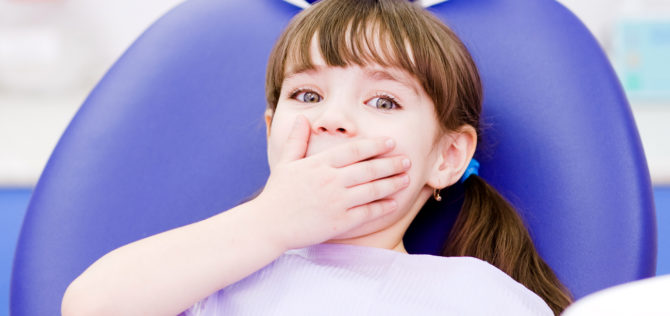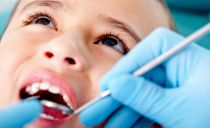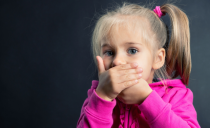A child has a milk or permanent tooth that hurts - how to anesthetize at home
No one is safe from toothache. This ailment can affect even a baby at the most tender age, so parents should be “fully armed” at the moment when the child’s tooth aches, they should know how to act and how to anesthetize him at home.
Content
Causes of Toothache
To understand how to act if a child has a toothache, than to help the baby at home, it is necessary to establish the cause of the symptom:
- Mechanical damage. When the baby eats solid food, it can get stuck between the teeth (for example, fish bone). In this case, it is enough to remove the object that causes pain, and they will pass. You can use dental floss, clean tweezers to extract stuck food.
- Gum disease It occurs with the eruption of milk and permanent teeth or with a complication of a dental disease (stomatitis, a non-healing hole after tooth extraction). If the pain is excruciating, then topical drugs will help get rid of it.
- Enamel damage. Chips, cracks, "holes" are dangerous because pathogenic microbes get into them, which contribute to the rapid destruction of enamel. If the lesion is not noticed timely or neglected, its further development inside the tooth is possible.
- Inflammation of the nerve or root is the final stage of tooth decay. The process is accompanied by the most painful pain symptoms. To reassure them, you can give your baby an anesthetic, given age restrictions.
Problems arising in the oral cavity in children cannot be solved independently, it is necessary to show the baby to the doctor.
Teething pain
For the first time, problems with teeth and gums appear in 5-7 months, when the baby begins to erupt milk teeth. The condition can manifest itself with the following symptoms:
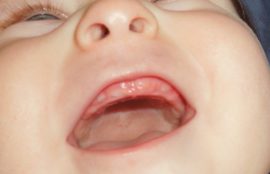 gums become sensitive, painful, swollen;
gums become sensitive, painful, swollen;- increased salivation appears;
- unpleasant itching occurs in the gums, the babies begin to “pull” everything in their mouths;
- due to discomfort, the child’s sleep is disturbed.
It is possible to alleviate the condition of the baby by massage of the gums, for this purpose, special silicone brushes purchased in a pharmacy are suitable. Cooled teething gums can also help. To relieve toothache in a child of three years and older, you can rinse your mouth with warm water.
In adolescence, when permanent molars begin to grow, it is more difficult to relieve a pain symptom. Ointments and topical gels can help a child with toothaches of a similar nature. They are able to quickly reduce discomfort during teething at any age.
Night toothache
Toothache often occurs in the middle of the night. A milk tooth can “give” the same powerful manifestations as a permanent one, so it is important that the “first aid” comes quickly. To alleviate the condition of the baby, you can use a children's pain medication, most importantly, give it to the crumb in the correct dosage.
Then you need to try to calm the baby so that he can sleep. Relieving his condition for a while, in the morning you will need to go to the pediatric dentist. In the event that night pain is accompanied by an increase in temperature, you need to immediately call an ambulance.
Acute tooth pain
If the visit to the dental office is temporarily delayed for any reason, and the baby’s toothache is too acute, you can anesthetize the tooth with a local anesthetic - novocaine, lidocaine. Such drugs are commercially available in the pharmacy and help to quickly relieve acute pain.
It is necessary to slightly moisten a piece of fleece with an anesthetic and apply it to a diseased tooth. The effect of the medicine is short-lived, but this time may well be enough to get an appointment with a doctor.
A tooth hurts under a filling
A tooth may become ill due to improperly placed fillings or poorly healed caries. In this case, painkillers and warm salt rinses will help relieve symptoms.
If the tooth is very painful, you can make a solution of Furacilin: 1 tablet should be dissolved in a glass of warm water - and use it for rinsing or bathing. But all these are just temporary measures, the main thing is to get an appointment with a dentist more quickly in order to get rid of a defective seal.
How to relieve toothache in children of different ages
First aid for dental troubles is to relieve pain. It is impossible to cure diseased teeth at home, but it is quite possible to calm the suffering of the baby before going to dentistry.
What can a child get from toothache:
- Acute manifestations are suppressed by analgesics - tablets, suppositories, syrups. When using them, you must definitely familiarize yourself with age-related contraindications.
- Dental gel relieves pain in the gums in infants and older children.
- Non-traditional methods have a calming effect, for example, acupressure, the use of which is allowed at any age.
- For children of four years and older, folk methods of pain relief are suitable. On younger children it is better not to experiment, as they may manifest an allergic reaction.
Pain relievers for toothache in children
For children of different ages, different medications are suitable. If a tooth hurts in a child under 5 years old, it is better to anesthetize it with gels and ointments. To stop the symptom in older children, tablets, syrups, suppositories and drops can be used.
Effective drugs:
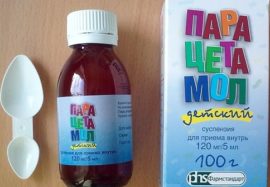 Paracetamol for children - allowed from three months. Analogs - Panadol, Tsefekon, Efferalgan.
Paracetamol for children - allowed from three months. Analogs - Panadol, Tsefekon, Efferalgan.- Ibuprofen - allowed from three months. The analogue is Nurofen.
- Nimesulide - allowed from the age of three. Analogs - Nise, Nimesil.
To choose a safe pain reliever for toothache in a child, it is important to pay attention to age restrictions and contraindications. When using the drug, the dosage must be strictly observed.
Gels for topical application can remove mild discomfort in the gums and teeth, act almost instantly, are allowed from a very young age, have analgesic, antibacterial and anti-inflammatory properties. Effectively manifest themselves:
- Chrysal gel.
- Calgel.
- Kamistad.
- Dentinox.
It is impossible to abuse drugs, no matter how safe they may seem. It is important to fight not with the symptom - toothache, but with the cause of its occurrence.
Homeopathic remedies
If a child has a milk tooth sore and his parents do not want to give him medications, they can resort to homeopathy. To remove painful sensations will help:
- Ointment Traumgel-C. Plant components of the drug relieve pain, swelling, inflammation.
- Drops Dentinorm Baby. In addition to anesthetizing the teeth, they bring relief in diseases of the nasopharynx.
- Candles Viburkol. Herbal baby remedy with antispasmodic, anti-inflammatory, analgesic properties.
Folk remedies
At home, you can relieve toothache in a child with the help of simple, reliable, time-tested folk remedies. Before using solutions and decoctions of natural ingredients, you need to make sure that the child is not allergic to this or that product.
Recipes:
- Soda-rinse reduces painful manifestations. Making a solution is very simple: salt and soda are taken in equal proportions (0.5 tsp each) and dissolved in a glass of warm water. You can rinse your mouth every 2 hours.
- When a child has an unbearably painful tooth, herbal infusions of chamomile, sage, calendula, oak bark, thyme, and lemon balm help well.
- For relief of acute symptoms, propolis is suitable. It is necessary to roll a ball from the product and “stick up” a little tooth with it.
- Leaves of valerian or plantain. Entire leaves of the plant are applied to the sore spot and kept until relief.
- Beet. Freshly squeezed juice is applied in the form of lotions on the painful area in the mouth.
- Massage. There are several types:
- Fingers of hands. In circular motions for 7 minutes, the index and middle fingers are massaged on the arm opposite the painful tooth.
- Point. For 5 minutes, the area between the thumb and forefinger is massaged in circular pressing movements.
- Jaws. It is necessary to "stroke" in a circle the area at the base of the upper or lower jaw.
What can not be done
If a tooth hurts in a child under 4 years old, it is better to use medicines in the form of gels or syrups. The older your baby, the greater the variability of drugs that are allowed to take. Whatever remedies for toothache in children are used - pills, gels, folk - remember the dosage and observe it.
In addition, you must adhere to such rules:
- It is unacceptable both to warm the sick side, and to subject it to hypothermia.
- Not all children under five years old can rinse their mouth without swallowing a solution, so they can not be treated with rinses. It is permissible to make oral baths - the solution is simply kept in the mouth for several minutes. Alcohol rinsing is prohibited for children of all ages.
- If the baby has a toothache, provide him with unstable and non-irritating delicate oral mucosa.
Anesthetizing a toothache in a child is not difficult, the main thing is not to harm him. But in order to avoid possible complications, you need to take your baby to the dentist as soon as possible.
Prevention
The development of diseased teeth in a child, and as a result, taking pills, can be avoided if timely introduced to the correct oral hygiene. Teach your baby to brush his teeth from an early age, do it twice a day: in the morning and at night. After each meal, rinse your mouth with clean water for the company with the baby. Limit the consumption of sweets, chewing gum.
So that you do not have to drill and remove the teeth of the child, independently examine his oral cavity at least once every two weeks. Take the baby to an appointment with a pediatric dentist at least 2 times a year.

